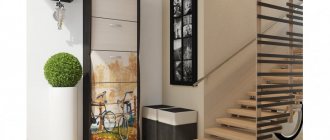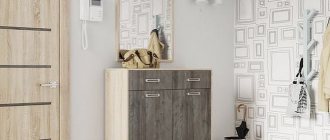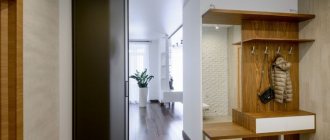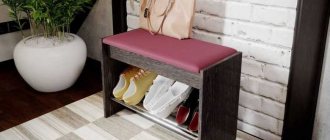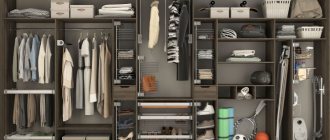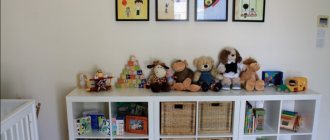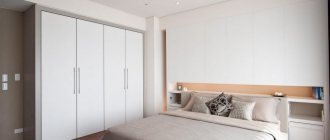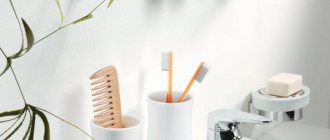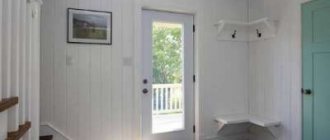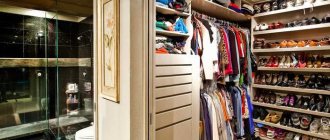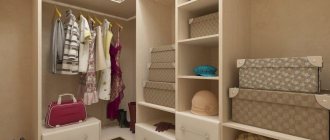For residents of small apartments, the issue of placing shoes in the hallway is a very pressing issue. Families with children know what it means to have shoes scattered throughout the apartment. The problem is no less pressing for those who like to select a variety of accessories to complement their look. To maintain order in your home and conveniently arrange each pair, it is not at all necessary to buy expensive shelves from the assortment of furniture stores. You can make convenient devices for storing shoes from available materials, if you show your imagination. Here are some examples for inspiration.
Shelf styles
Like any other piece of furniture, the shelf must match the chosen interior style of the room. For high-tech and loft, simple models made of metal and pipes are suitable. This option will look especially colorful against the backdrop of the “branded” brickwork in the hallway. For a group of rustic styles headed by Provence, open-type wooden shoe racks are suitable. The surface of the product is covered with discreet paint and artificially aged. This option will look great in combination with wicker boxes-baskets, which are placed on the upper tiers. For country music, you can choose a model from boxes that are placed on top of each other, after which the entire structure is secured with glue. For minimalism, original options are used. For example, a product that can hardly be called a “shelf” in the truest sense of the word: a row of vertical poles on a stand. Each one is “put on” a boot. For classic styles, luxurious closed models with carved doors are used. They also go well with elegant banquettes on twisted legs with a storage system located under the seat.
Selection of materials
The main material for the manufacture of storage systems is wood, its derivatives (MDF, chipboard), PVC pipes, metal, metal profiles and even thick cardboard and laminate. Also suitable for work are pallets - wooden pallets used in construction. In some models, materials are combined. For example, the frame of a shelf (overshoe) can be made of metal tubes, and the shelf-beams can be made of wood or plywood.
Master classes and unusual solutions for making shelves with your own hands
Before work, you need to decide on two main nuances:
- Shelf design.
- Materials.
The more complex the design of the product, the more skill and time it will take to create it. For beginners, it is better to start with simple forms of shelves or tables, cupboards combined with shelves.
From chipboard
You can make an original, designer model of a shoe rack from chipboard. Let's consider the process of manufacturing an unusual labyrinth design. To work you will need:
- Jigsaw.
- Chipboard sheets.
- Pins and special glue.
- Screwdriver.
- Grinding machine for processing cuts.
- Tape measure and pencil.
- Iron and edge tape.
- A utility knife for trimming excess tape.
- Confirmations, screws, plugs.
- Square.
- Drill.
This design has an arbitrary number of shelves, which form a system with different-sized “cells”. Chipboard must be cut into separate modules. They can be divided into two types:
- Four parts for the sides, lid and bottom tray.
- Modules of the same length, from which elements in the shape of the letter “P” will be formed.
The last parts fill the interior of the box in random order. How exactly the shelves will be located depends only on the imagination of the master. The parts are connected to each other using confirmations. First, using a hot iron, glue the edge tape to the sections.
Made of wood
Wooden boards in processed form can be purchased at any hardware store. All that remains for the craftsman to do is trim and correctly connect the parts. To work you will need the following set of tools and materials:
- Saw.
- Tape measure, pencil.
- Self-tapping screws and screwdriver.
- Metal corners.
- The boards themselves.
- Sandpaper.
- Varnish or paint.
- Drill.
First you need to decide on the design of the future shoe rack. It is better to make a sketch on a piece of paper in advance. On the drawing you must immediately indicate the length, width and depth of the shelf. Let's look at the process of creating a shoe rack using the example of a simple open shoe rack:
- The lines of future cuts are marked on the boards. You will need to cut two sides, the lower and upper parts (lid), and the transverse shelves directly under the shoes.
- After this, you can start cutting the boards using a saw. Uneven cuts are sanded with sandpaper.
- Then the assembly begins. The shelves and the top/bottom cover are attached to the sides using self-tapping screws, corners and a screwdriver. At the fastening points, holes with a slightly smaller diameter than self-tapping screws are pre-drilled.
- The surface of the shoe rack is covered with varnish or paint.
After the composition has dried, the finished shelf can be placed in the hallway or corridor and shoes can be placed on it. Instead of classic board sides, you can use bars, bricks or even glass bottles. For the latter option, you will have to cut holes in the shelves for the necks on which they will be “put on.” The option using bricks is suitable for the laziest. This composition is not suitable for every style. It will look best in an industrial interior. First, “legs” are formed from bricks stacked in two or three rows. After this, the first shelf is attached to them. Then there is a second side row of bricks and again a horizontal crossbar. The number of floors of such a rack is unlimited. Over time, you can even add new shelves to the structure.
Made of metal
To make a simple metal shelf, you don’t need to pore over in a forge. Laconic shelves made of thin tubes are very popular in modern interiors. Modules of different lengths are cut out of them, which are then fastened together using fittings (tees, angles). The edges are sealed with plugs, and the structure itself is fixed to the wall. Pipes must be coated with a special anti-corrosion compound, which will protect the material from the harmful effects of moisture. You can use special paint with the effect of bronze, silver or gold. This shelf is ideal for interiors in steampunk, retro and loft styles. For minimalism, an even simpler design is used in the form of a “bare” frame. Hooks are attached to its crossbars, on which shoes will subsequently be hung.
From plywood
Working with plywood is in many ways similar to making a chipboard shelf. However, the material has several advantages compared to its main competitor:
- Plywood has better moisture resistance than chipboard. After getting wet, which often happens with “street” shoes, the material will dry out and not deform. Chipboard may lose its shape.
- For many aesthetes, plywood is more visually attractive than chipboard. It is quite often used in its raw form for final repairs.
- Plywood has higher abrasion resistance than chipboard, which begins to crumble over time.
Large, full-fledged semi-closed plywood shelves (with a backdrop) look best, which are filled with numerous shelves of different sizes in random order.
From wooden slats
To make a shoe rack from wooden slats, you will need the following tools:
- Sandpaper.
- Screwdriver.
- Self-tapping screws for wood.
- Hacksaw.
- Paint or varnish.
You can get by with slats alone or combine them with bars that will play the role of sidewalls. Let's consider the first option:
- First, measurements are taken and a drawing of the future structure is drawn.
- After this, marks are made on the slats for cutting.
- The material is cut into the required number of modules. You will need four racks for the sidewall, paired supports for each shelf, and the shelves themselves.
- The modules are connected to each other in accordance with the drawing. Work should begin from the bottom shelf.
- The structure is coated with varnish or paint. If necessary, the cut areas are pre-treated with sandpaper.
After the composition has dried, the shoe rack can be used for its intended purpose.
From laminate
You can quickly make a simple shelf out of laminate. To work, you only need basic material and metal tubes. The number of laminate sheets depends on the size of the future shoe rack. Slots are made in metal tubes using a grinder. Then shelves are inserted into them. Plugs are attached to the ends of the tubes to protect the holes from dirt and dust.
From a metal profile
The metal profile in the stylish homemade shoe rack harmoniously combines with the tempered glass from which the shelves are made. To work you will need:
- Screwdriver.
- Drill.
- Level, roulette.
- Bulgarian.
- Jigsaw.
- Glass cutter for shelves.
Metal profiles make unusual wall-mounted shoe racks. First you need to take measurements, fix the guide to the wall using self-tapping screws and check how level it is using a level. After this, you can assemble the frame from the metal profile. Then the shelves are made using a glass cutter. Tempered glass is inserted into special niches in the frame and the shoe rack is ready. This design will ideally emphasize the coldness of high-tech and the laconicism of modern style.
From boxes
This may seem surprising, but quite strong, wear-resistant furniture can be made from thick cardboard. The only drawback of this material is the lack of protection against moisture, which cannot be compensated for in any way. A structure is assembled from several modules, which are cut out of boxes. Each part is manufactured separately. A piece is cut off from the box along with the bottom. The height of the module will be equal to the depth of the future shelf, since it will be located horizontally (i.e., the bottom will “look” at the wall). Each part is covered with a second layer of cardboard to give additional strength. After all the modules are ready, they are connected to each other, placing them on top of each other. It turns out to be a compact bookcase. Since the cardboard surface has a rather unsightly appearance, it is additionally covered with paper.
From wooden boxes and pallets
Shelves made of pallets and boxes are considered, perhaps, the most laconic and easiest to manufacture. The structure can be built in just a few hours. The construction pallet is thoroughly sanded using sandpaper or a sanding machine. Then it is coated with a special moisture-repellent composition. After this, the pallet is brought into a vertical position and simply leaned against the wall. Shoes are placed in the spaces between the cross boards. To make a classic shelf, the pallet is cut into several parts, which are connected to each other in the manner of a shelf, separated by bars. The structure of the boxes is assembled using glue. The material is also pre-sanded and coated with a special protective compound. After assembling the structure, it can be coated with paint. There is also a wall-mounted option for the “lazy”. The boxes are painted in different colors, based on the principle of analogy or contrast, and screwed to the wall, leaving gaps between the modules. The composition takes up exactly as much space as the master allocates for it. Some drawers can be “broken” inside using shelves. In the future, they will be used for “low” shoes (boots, shoes). Others decorate with vertical partitions. This option is suitable for compact storage of summer shoes (slippers, flip-flops, flip-flops). Those boxes that remain untouched are used to place high boots. This method of organization looks bright, cheerful and slightly chaotic, which is why it is suitable exclusively for light styles: fusion, eclecticism, ethnicity, a group of rustic trends.
Made from PVC pipes
A shoe rack made of PVC pipes is quite simple to make. To work you will need the following tools:
- Special knife for cutting plastic.
- Glue.
- Pipes.
The structure will have a “honeycomb” shape. This shelf is assembled according to the principle of a designer: it is convenient to add new modules to it and easily give it the most bizarre configuration. The pipes are cut into pieces of equal length so that the shoes fit. Then these models are connected to each other by gluing them on their sides. The finished structure can be coated with paint or pasted over with any available material. Even not very clean shoes can be placed in a PVC shelf, since the material, unlike wood and metal, is not susceptible to moisture.
Round rotating cabinet
Making a round rotating shoe rack is not as difficult as it might seem at first glance. For work you will need sheets of chipboard or plywood at the choice of the master. You need to make several preparations:
- Round for shelves.
- In the form of rectangles for internal cross-supports on which the entire structure will be supported.
To carefully mark circles on a sheet of material, you can use a special compass or use the old “old-fashioned” method using a thread, which is fixed in the center of the future circle, and then the outline of the figure is traced with a pencil attached to the other end. Uneven cuts should be sanded with sandpaper or a sanding machine. After this, they are decorated with edge tape, which is glued using a hot iron. Then the rectangular elements are connected to each other, forming crosses. The number of these parts depends on how many spaces there will be between the shelves, that is, on the number of storeys of the shoe rack. Every two adjacent circles are connected using crosses. Work begins from the lower tier. Finally, a special rotating stand mechanism is attached to the bottom.
Shoe rack pouf/bench
In fact, this is an ordinary shoe rack, which is covered on top not with an ordinary lid, but with a tabletop or seat. You can assemble a shelf from solid wood or chipboard, sometimes using bars. If the shoe rack will be used as a bench for changing shoes, then the structure must be additionally strengthened to increase the safety margin. Instead of assembling a new shelf, you can use an old chest. It is sanded, covered with a layer of varnish, paint or covered with paper. The storage system is formed from sheets of plywood, making a “lattice”. Its width should be equal to the height of the chest, since it should be placed inside upside down. Shoes are placed vertically in it. The top of the chest lid is covered with soft pillows or a special seat for ease of use.
DIY corner cabinet
To make a corner cabinet, it is better to use plywood, chipboard or wood. The shelf will have backdrops, from the connection of which work on assembling the structure will begin. You also need to cut two identical parts for the tray and lid. It is better to smooth out concave areas and make them semicircular. You will have to tinker with cutting the material, but the result is worth it. Soft, wavy lines are suitable not only for the Art Nouveau style, but will also organically blend into any modern or classic direction. The lid and tray are connected to the sides, after which they begin to work with filling the shelf.
